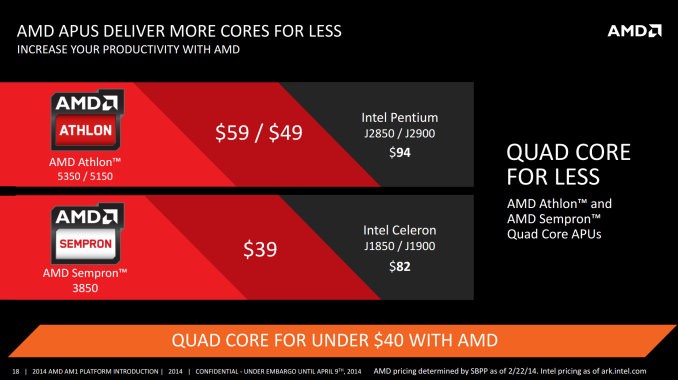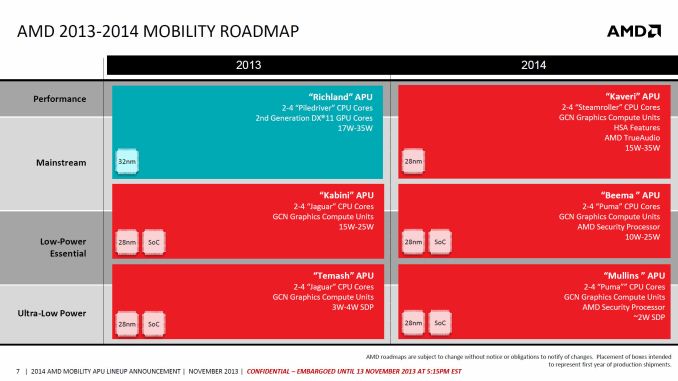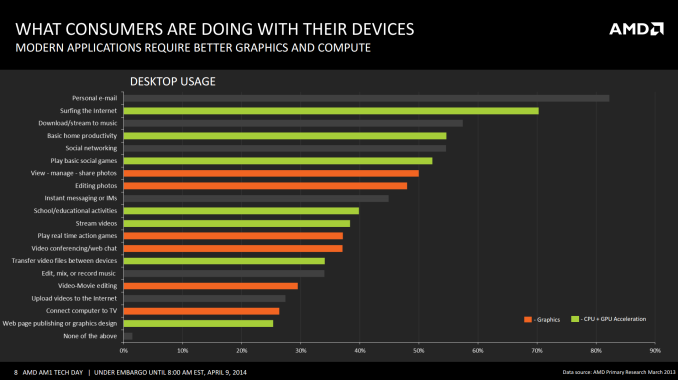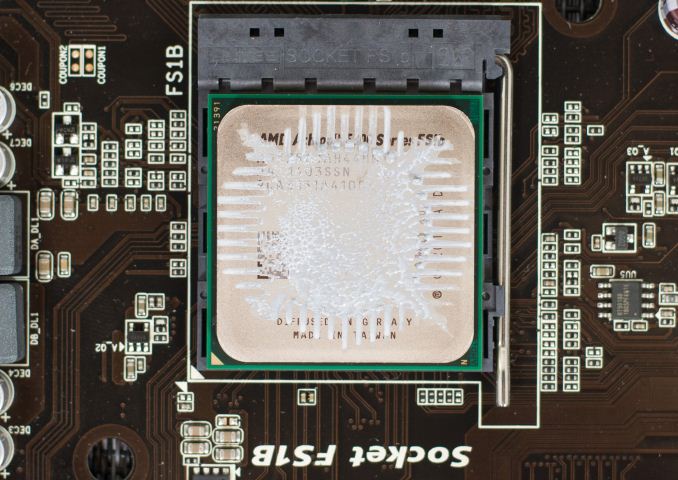The Desktop Kabini Review Part 1: AMD Athlon 5350 (AM1) Tested
by Ian Cutress on April 9, 2014 8:00 AM ESTFinal Words
As mentioned in our test setup, the benchmark results in this preliminary article are only a small fraction of our normal coverage. Due to other commitments we were unable to run every test on all comparison systems, but we have the other Athlon and Sempron APUs as well as comparable Intel counterparts coming in for review.
The poignant place to start with the final analysis is AMD’s claim of ‘Quad Core for Less’. In this statement alone, they are not wrong. Intel cannot provide a socketed quad core processor for less than $36 (Sempron 3850). The cheapest all-in-one desktop quad-core system from Intel equips the Celeron J1900 onto a motherboard for $92, which is exactly where AMD sit with the top-end Kabini based Athlon 5350 with a motherboard. One of the issues to consider at this point however is that Intel offers several dual core options (non-Atom) around this $40-$60 price point, and in many cases the IPC and CPU speed advantage of these cores is greater than that provided by Kabini, particularly in single threaded applications. The only downsides to this solution are the power consumption is higher, and the motherboards are more expensive. For a competitive socketed Intel dual core, a motherboard plus CPU can be in the region of $110-$120 at 35W-55W.
The big upside and selling point from the AM1 Kabini platform should be upgradeability. If a user buys an AM1 platform now, they should be able to upgrade it in the future. While AMD has not yet confirmed if Beema is coming to the socketed platform, the roadmaps suggest that the laptop sockets are remaining consistent from Kabini to Beema. This should imply that if Beema gets a socketed version, it should also remain based on AM1/FS1b.
If we compare single threaded performance between Kabini and our J1800 test system, the benchmarks are almost even between the two, particularly when it comes to synthetics such as Cinebench, but falls behind on emulation such as the Dolphin Benchmark and 3DPM. The integrated graphics of the Kabini pull ahead when it comes to gaming, despite the single channel memory interface.
|
AMD Athlon 5350 vs. Intel Celeron J1800 Single Threaded |
||
| Athlon 5350 | Celeron J1800 | |
| Cinebench R10 | 1967 | 1917 |
| Cinebench R11.5 | 0.51 | 0.49 |
| Dolphin Benchmark | 40.4 | 38.02 |
| 3DPM | 53.29 | 69.20 |
When placing Kabini against any Intel Ivy Bridge socketed processor, the increased IPC and frequency pushes the system above the Kabini, in exchange for more power and a more expensive system overall. If we compare the Kabini single-threaded results to those of the Celeron G465, a Sandy Bridge based single core CPU at 1.9 GHz, the Celeron does pull ahead on the majority, but fails miserably in the graphical benchmark suite.
|
AMD Athlon 5350 vs. Intel Celeron G465 Single Threaded |
||
| Athlon 5350 | Celeron G465 | |
| Cinebench R10 | 1967 | 2975 |
| Cinebench R11.5 | 0.51 | 0.73 |
| Dolphin Benchmark | 40.4 | 38.8 |
| 3DPM | 53.29 | 59.98 |
Does it seem particularly odd that a modern Kabini architecture at 2 GHz cannot keep up with a 3 year old Sandy Bridge processor at 1.9 GHz at our simple benchmarks? AMD is leveraging on the fact that much of what we do on a computer as a casual user can leverage the fixed function units of the graphics center of the APU:
AMD’s key in all of this is leveraging the GPU. For non-GPU intensive tasks, on paper, the J1900 for $92 and 10W TDP would seem to be the choice if upgradability is not a concern. The remit of AM1 and Kabini could be extended if motherboard manufacturers decided to use those extra PCIe lanes. Consider an AM1 with controllers to make a nice routing system (4x NIC) or something based around storage (SATA controllers and hubs). But because Kabini is also a cost play for AMD at the low-end desktop segment, margins are going to be ultra-tight for motherboard manufacturers and I do not imagine that as much effort will be put into making innovative products as the rest of their product range on other sockets.
In order for the upgradability angle to work, AMD need to keep the sockets around for at least two generations. AM1 comes late in Kabini’s life cycle, given that Beema on the mobile side is due out later in 2014. It would make sense for AMD to release Beema desktop parts, but the big question there is when. AMD could launch new processors on day 1 of Beema, or further into the life cycle. I would imagine that depends on what the competition does. AMD does have that advantage of having an upgradeable platform before Intel; however Intel may see the market differently. It is a hard one to judge.
Stay tuned for our full benchmark suite on the other AMD Kabini APUs.














126 Comments
View All Comments
Medallish - Wednesday, April 9, 2014 - link
Well sadly it's not $35, but $59 But it does come with two extra Sata III ports, and the ability to plug a 19V DC directly into the boardhttp://www.newegg.com/Product/Product.aspx?Item=N8... Should be said the cable that comes along with it to supply drives with power directly from the motherboard, only supports 2 drives, so yeah if you do use that port you likely need to come up with an inventive way of supplying 2 additional drives.
If I were building a mini server though I'd likely to a little crazy and get this:
http://www.newegg.com/Product/Product.aspx?Item=N8...
6x Sata III ports and 1x mSata & 1x eSata. And then get some Richland or Kaveri APU as cheap and low power as they get with onboard GPU.
I'm sure you'll get a lot of other replies with even better suggestions.
Communism - Wednesday, April 9, 2014 - link
Lol @ those prices,37 USD motherboard:
BIOSTAR H61MGV3 LGA 1155 Intel H61 Micro ATX
http://www.newegg.com/Product/Product.aspx?Item=N8...
43 USD CPU/GPU:
Intel Celeron G1610 2.60GHz LGA 1155 Processor
http://www.amazon.com/Intel-Celeron-2-60GHz-Proces...
Desktop Kabini is DOA for it's intended purpose.
Medallish - Wednesday, April 9, 2014 - link
I love it when people trot out a H61 based board like it renders Kabini useless, completely missing the fact that it compared to Kabini misses a lot, with H61 you only get USB 2.0 and Sata II.And then there's that wonderful 55W CPU you put in there that I'm sure doesn't even compare on GPU performance to the Kabini and only is slightly ahead in CPU bench's.
I built a kabini system using this case:
http://www.chieftec.eu/en/chassis/itx-tower/ix-01b...
And the Asrock board:
http://www.asrock.com/mb/AMD/AM1H-ITX/
I got a board with a lot more functions, and an incredibly simple build thanks to the DC-In port, and still incredibly cheap. Kabini is like the perfect build for a lot of my family members who still can get use out of newer standards like Sata III and USB 3.0
meacupla - Wednesday, April 9, 2014 - link
Do you really think the presence or not of SATA3 matters in such a low end system?USB3.0 is nice, however.
Medallish - Wednesday, April 9, 2014 - link
Might not be a selling point telling someone with no clue, that it has Sata III certainly, but IO performance adds to the "feel", and on that front I would definitely say it can matter.fokka - Wednesday, April 9, 2014 - link
sure i'd prefer sata3 too, but the IO performance you're talking about isn't hindered much by sata2. max throughput is capped in half, yes, but once you go random rw, sata2 shouldn't be the limiting factor.MrSpadge - Wednesday, April 9, 2014 - link
Once you're transferring at 270 MB/s (SATA2) the feeling is pretty good. And during installs & loads the CPU has to keep up, too.rudolphna - Wednesday, April 9, 2014 - link
Well. Here is the thing. I have a Celeron g1610 on a mATX b75m board that together cost me $105. I use our for network storage and as a plex server which is real-time h264 encoding. I tested it with handbrake. Under handbrake h264 encoding using the igp for display, the g1610 pulled a maximum of 17w according to coretemp, not 55 or anywhere close to it. It generally runs sub 10w, when doing a single plex encode.Medallish - Wednesday, April 9, 2014 - link
I really wouldn't count on Software to get a accurate meassure of that, and TDP != Power use, it simply refers to the cooling requirement, I'm pretty sure the 5350 and 5150 don't use the same amount of power, despite them both having a TDP of 25W.frozentundra123456 - Wednesday, April 9, 2014 - link
Upgradability is nice, but the problem is upgrade to what. Right now there is no real upgrade path, and it is unknown what and when the next upgrade will be. Seems like another very niche product, like the rest of AMD APUs, trying to use the graphics to leverage an advantage against higher power consumption and mediocre cpu performance. So far this strategy hasnt really been successful, as the marketplace shows. That could change as more apps use graphics, but IMO single core performance (and power consumption in a small envelope like this) is still king.